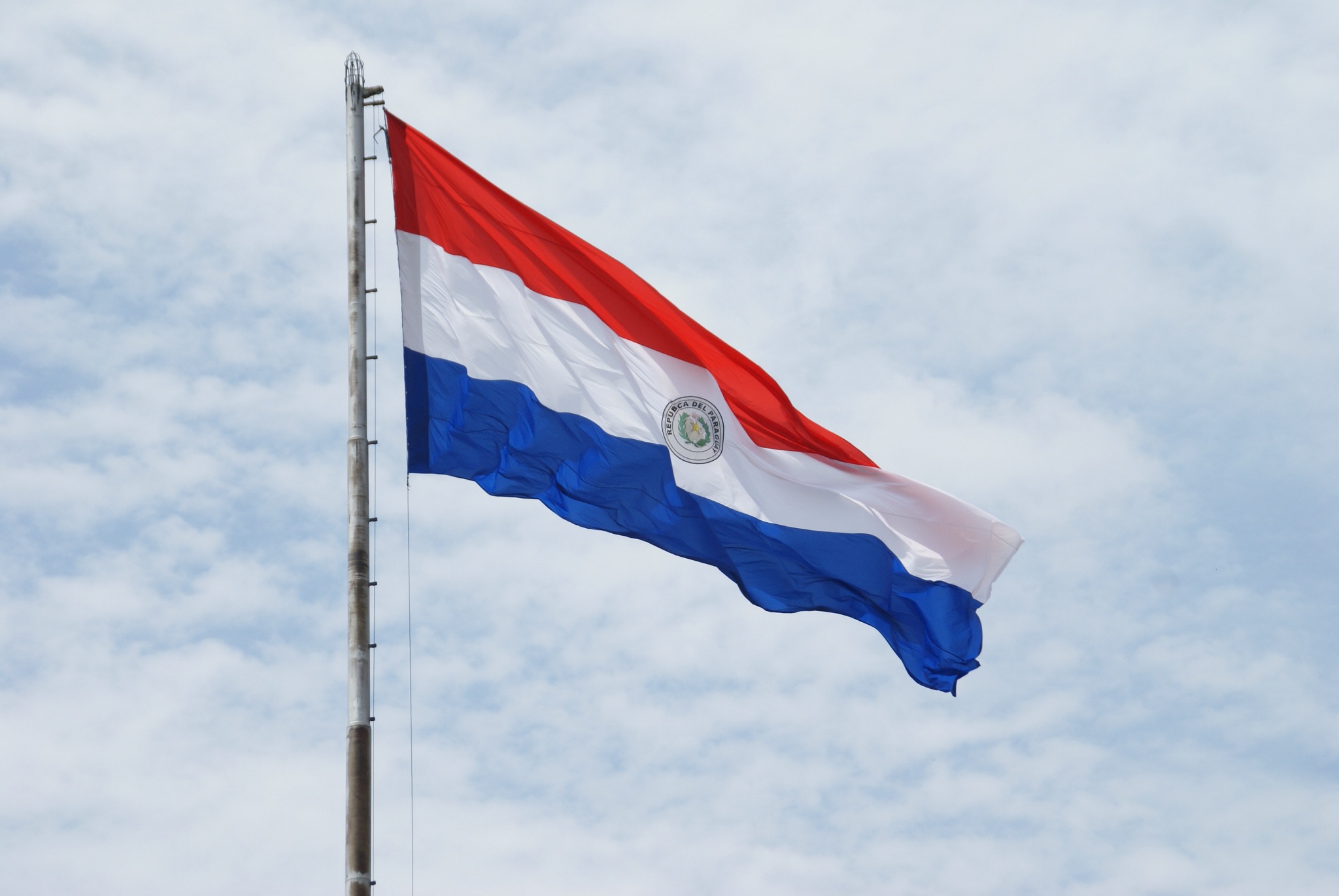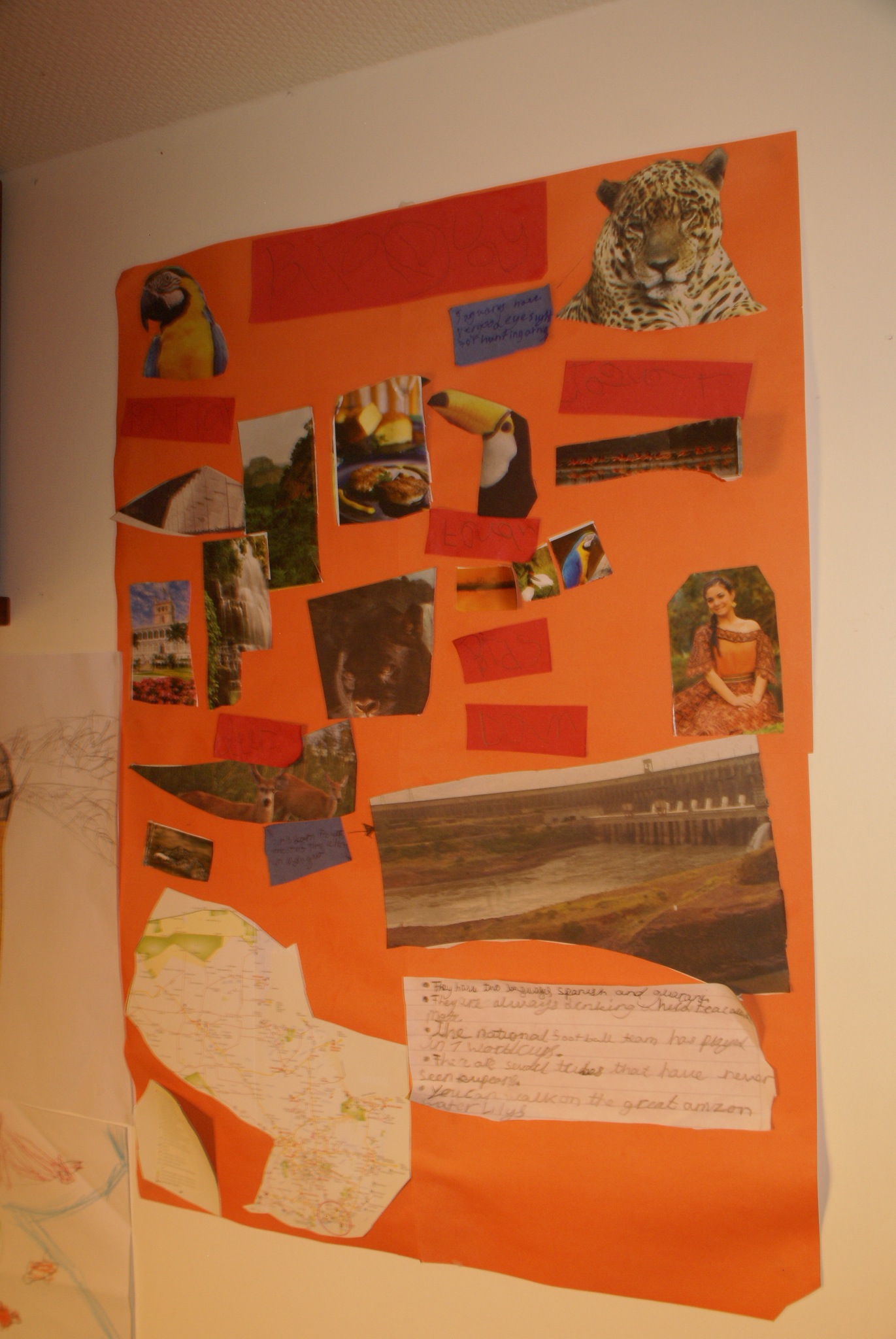
Lucy
It was sooooo hot when we drove across the Chaco I had to take all my clothes off, apart from my knickers. There are so many places in Paraguay where there is so many mosquitoes. I must be super tasty as they kept on eating me.
We thought we saw a big bit of rubber in the road but then it moved, it was a long green snake. We went to this campsite with howler monkeys, marmoset, parrots and lots of fish and snakes but me and Alisha's favourite animal was a baby rabbit. I got to hold it and feed it carrot.
Alisha
After leaving Argentina we found our way to Paraguay. Paraguay is a sociable, friendly country and I made several friends but nothing could distract me from my dreadful mosquito bites. They tortured me through the night and all day, I'll be glad when we get to the mountains (Steve's comment: at least 3 months away!).
Lucy and I made a poster about Paraguay in school:

Gilly
We've enjoyed our time in Paraguay, it is quite a diverse country in terms of geography, the wet red clay of the east to the dry Chaco of the west, and population. So it has been hard to get a fully formed opinion on the place, especially after just 9 days. It's a country of farms, crops to the east and cattle to the west. With most of the population centred around the riverside capital Ascuncion. Most of the farming we've seen hasn't been intensive though, leaving large sways of overgrown pasture to admire. The heat and mosquitoes have been a bit of a shock after our Southern Hemisphere winter but we are getting used to it and adjusting our routine to cope.
The missions were set up by Spanish Jesuits in the 17th Century, not only to teach about God but also as collective farms with the Guarani Indians. This also helped protect the Indians against Portuguese slave traders. It was fascinating to learn about these unusual societies and how they divided opinions: to many they were seen as utopian societies but to the Spanish and Portuguese rulers they were a huge headache, especially as they were their commercial competition. Eventually the Jesuits were expelled, mostly due to political wrangling in Europe. The missions dissolved and the Guarani suffered at the hands of the slave traders.
Steve
We only spent 9 days in Paraguay so it was not possible to get a full feel for the country. In reality the country consists of two parts. The Eastern side is lush, verdant with thick red mud. This is where most of the population lives and is heavily farmed. The Western side consists of the Chaco which is virtually unpopulated and starts off fairly wet and swampy but gets gradually drier as you move west.
Very few tourists visit Paraguay and there are hardly any guide books. Instead we read "At the tomb of the Inflatable Pig" which is a travel book written just over 10 years ago that takes you through Paraguayan history. Not that it is a very pretty history. One of conquest, dictators, horrors and some dreadful wars. The Paraguay we saw seemed more settled and starting to prosper. Tourist infrastructure was been put in place and whilst there are still lots of poor around there is also a growing middle class.
Paraguay for us was also a return to the heat. And whilst it is only spring here the thermometer still touched 40 degrees. Whilst the Missions were interesting I found the endless Chaco enthralling. Whilst we did not see much wildlife the landscape was fascinating. There are large cattle farms along the road but in effect the cattle just roams in the natural vegetation. Unfortunately we could not drive the whole Chaco otherwise we would have been back in Bolivia so half way along we turned East again for Brazil.
 Lucy
It was sooooo hot when we drove across the Chaco I had to take all my clothes off, apart from my knickers. There are so many places in Paraguay where there is so many mosquitoes. I must be super tasty as they kept on eating me.
We thought we saw a big bit of rubber in the road but then it moved, it was a long green snake. We went to this campsite with howler monkeys, marmoset, parrots and lots of fish and snakes but me and Alisha's favourite animal was a baby rabbit. I got to hold it and feed it carrot.
Alisha
After leaving Argentina we found our way to Paraguay. Paraguay is a sociable, friendly country and I made several friends but nothing could distract me from my dreadful mosquito bites. They tortured me through the night and all day, I'll be glad when we get to the mountains (Steve's comment: at least 3 months away!).
Lucy and I made a poster about Paraguay in school:
Lucy
It was sooooo hot when we drove across the Chaco I had to take all my clothes off, apart from my knickers. There are so many places in Paraguay where there is so many mosquitoes. I must be super tasty as they kept on eating me.
We thought we saw a big bit of rubber in the road but then it moved, it was a long green snake. We went to this campsite with howler monkeys, marmoset, parrots and lots of fish and snakes but me and Alisha's favourite animal was a baby rabbit. I got to hold it and feed it carrot.
Alisha
After leaving Argentina we found our way to Paraguay. Paraguay is a sociable, friendly country and I made several friends but nothing could distract me from my dreadful mosquito bites. They tortured me through the night and all day, I'll be glad when we get to the mountains (Steve's comment: at least 3 months away!).
Lucy and I made a poster about Paraguay in school: Gilly
We've enjoyed our time in Paraguay, it is quite a diverse country in terms of geography, the wet red clay of the east to the dry Chaco of the west, and population. So it has been hard to get a fully formed opinion on the place, especially after just 9 days. It's a country of farms, crops to the east and cattle to the west. With most of the population centred around the riverside capital Ascuncion. Most of the farming we've seen hasn't been intensive though, leaving large sways of overgrown pasture to admire. The heat and mosquitoes have been a bit of a shock after our Southern Hemisphere winter but we are getting used to it and adjusting our routine to cope.
The missions were set up by Spanish Jesuits in the 17th Century, not only to teach about God but also as collective farms with the Guarani Indians. This also helped protect the Indians against Portuguese slave traders. It was fascinating to learn about these unusual societies and how they divided opinions: to many they were seen as utopian societies but to the Spanish and Portuguese rulers they were a huge headache, especially as they were their commercial competition. Eventually the Jesuits were expelled, mostly due to political wrangling in Europe. The missions dissolved and the Guarani suffered at the hands of the slave traders.
Steve
We only spent 9 days in Paraguay so it was not possible to get a full feel for the country. In reality the country consists of two parts. The Eastern side is lush, verdant with thick red mud. This is where most of the population lives and is heavily farmed. The Western side consists of the Chaco which is virtually unpopulated and starts off fairly wet and swampy but gets gradually drier as you move west.
Very few tourists visit Paraguay and there are hardly any guide books. Instead we read "At the tomb of the Inflatable Pig" which is a travel book written just over 10 years ago that takes you through Paraguayan history. Not that it is a very pretty history. One of conquest, dictators, horrors and some dreadful wars. The Paraguay we saw seemed more settled and starting to prosper. Tourist infrastructure was been put in place and whilst there are still lots of poor around there is also a growing middle class.
Paraguay for us was also a return to the heat. And whilst it is only spring here the thermometer still touched 40 degrees. Whilst the Missions were interesting I found the endless Chaco enthralling. Whilst we did not see much wildlife the landscape was fascinating. There are large cattle farms along the road but in effect the cattle just roams in the natural vegetation. Unfortunately we could not drive the whole Chaco otherwise we would have been back in Bolivia so half way along we turned East again for Brazil.
Gilly
We've enjoyed our time in Paraguay, it is quite a diverse country in terms of geography, the wet red clay of the east to the dry Chaco of the west, and population. So it has been hard to get a fully formed opinion on the place, especially after just 9 days. It's a country of farms, crops to the east and cattle to the west. With most of the population centred around the riverside capital Ascuncion. Most of the farming we've seen hasn't been intensive though, leaving large sways of overgrown pasture to admire. The heat and mosquitoes have been a bit of a shock after our Southern Hemisphere winter but we are getting used to it and adjusting our routine to cope.
The missions were set up by Spanish Jesuits in the 17th Century, not only to teach about God but also as collective farms with the Guarani Indians. This also helped protect the Indians against Portuguese slave traders. It was fascinating to learn about these unusual societies and how they divided opinions: to many they were seen as utopian societies but to the Spanish and Portuguese rulers they were a huge headache, especially as they were their commercial competition. Eventually the Jesuits were expelled, mostly due to political wrangling in Europe. The missions dissolved and the Guarani suffered at the hands of the slave traders.
Steve
We only spent 9 days in Paraguay so it was not possible to get a full feel for the country. In reality the country consists of two parts. The Eastern side is lush, verdant with thick red mud. This is where most of the population lives and is heavily farmed. The Western side consists of the Chaco which is virtually unpopulated and starts off fairly wet and swampy but gets gradually drier as you move west.
Very few tourists visit Paraguay and there are hardly any guide books. Instead we read "At the tomb of the Inflatable Pig" which is a travel book written just over 10 years ago that takes you through Paraguayan history. Not that it is a very pretty history. One of conquest, dictators, horrors and some dreadful wars. The Paraguay we saw seemed more settled and starting to prosper. Tourist infrastructure was been put in place and whilst there are still lots of poor around there is also a growing middle class.
Paraguay for us was also a return to the heat. And whilst it is only spring here the thermometer still touched 40 degrees. Whilst the Missions were interesting I found the endless Chaco enthralling. Whilst we did not see much wildlife the landscape was fascinating. There are large cattle farms along the road but in effect the cattle just roams in the natural vegetation. Unfortunately we could not drive the whole Chaco otherwise we would have been back in Bolivia so half way along we turned East again for Brazil. 